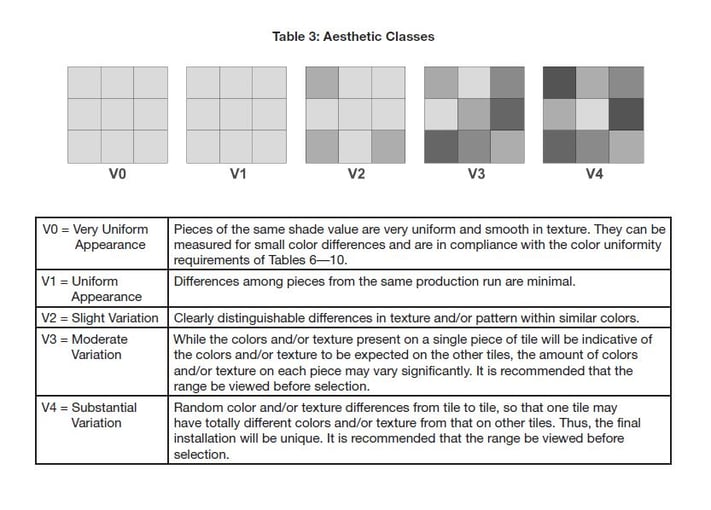Address
No. 3F07, Tao Cube, No.68, CCIH, Jihua West Road,Chancheng District, Foshan City, Guangdong, China.
How to Prepare for Tile Shade Variation

How do you handle tile shade variation? Do you make a point of bringing it up with customers before starting a tile installation project? If you don’t, I urge you to do so. Not only is it a great opportunity to educate your customers about tile installation methods, standards and best practices, but it also helps you avoid what I refer to as the “Five-O-Five Surprise.”
What is the Five-O-Five Surprise?
Almost every residential installer has heard the phrase uttered from a surprised customer at five minutes after five o’clock in the afternoon, after the tile has been installed, something like,
“That is not the tile that I picked!”
or
“My newly tiled floor doesn’t look anything like the sample board.”
This gut wrenching feeling may occur when the client is not fully aware of shade variation that can occur with ceramic and porcelain tiles.
Hopefully, it wasn’t your customer and you gained this valuable lesson from someone else’s mistake or oversight, but it could happen to you if you are not careful.
Five Recommendations for Preparing Yourself and Your Client for Shade Variation
As I mentioned, shade variation can occur with ceramic and porcelain tiles. It can also happen as a result of new tile trends where designs purposely exhibit substantial variation in pattern from tile to tile.
Here are five recommendations:
1. Inform and educate consumers about shade variation
Inform consumers that the tile they receive most likely will not look exactly like the piece on the sample board.
This variation in shade, some very subtle and some widely varied, is possible.
2. Refer to a tile shade variation chart
Oftentimes, a visual on shade variation is worth a thousand words. Look for it and refer to it with customers.
Most sample boards or tile literature now list a range of shade, tone, texture and color as found in the TCNA Handbook and similarly in the ANSI A137.1 Specifications for Ceramic Tile.
This chart, as shown in Table 3 below, ranges from V0 (zero) which exhibits no shade range detectable by the average eye to the potentially extremely varied color and tone of a V4.
You’ll find more detail in the section below titled “Tile Shade Variation Categories.”
3. Be cautious of tile selections made from an image
Be especially cautious of consumers who make tile selections from a single color photo or image online.
While being a great way to save time, there is nothing like seeing, touching, experiencing and knowing all about their selection before the tile is ordered.
Additionally, a computer or tablet monitor may not be color perfect. There’s no recourse once you’ve installed the tile, except to remove it and start over.
4. Encourage customers to look at several pieces of tile
Compounding the 5:05 surprise is when consumers select tile without the assistance of a knowledgeable installer or salesperson to guide and counsel on how the end result might look.
That is particularly true if they select tile based on a single piece of tile or from a small cut piece on a sample board. One single piece of tile cannot adequately represent the overall effect of a roomful of that tile installed. You can imagine how painful the results can be!
Rather, have several tile pieces available to make the point about shade variation especially if the individual tile exhibits variation in the V2 to V4 range (see below).
5. Insist on a mockup!
The safest way to eliminate the “Five 0 Five” surprise is to provide your customer with a mounted and grouted panel that shows the tile shade variation and pattern layout (if the job calls for it) along with the size and color of the grout joint before the job begins.
When this is approved, the customer should sign and date the back of the mockup which offers proof that the entire spectrum of the tile job has their approval.
>> See Why a Tile Installation Mockup is Really Necessary
You may say that following this procedure will cost you additional time and money, which it does, but this cost is minimal when compared to the cost of a possible tear out and replacement.
I assure you that finding and fulfilling your customers’ tile desires in advance will save a lot of headaches and money.
Tile Shade Variation Categories: V0 to V4
Here is the chart I referred to above, along with detail on each of the variation categories.

V0 = Very Uniform Appearance
Pieces of the same shade value are very uniform and smooth in texture.
They can be measured for small color differences and are in compliance with color uniformity requirements.
V1 = Uniform Appearance
Differences among pieces from the same production run are minimal.
V2 = Slight Variation
You’ll notice clearly distinguishable differences in texture and/or pattern within similar colors.
V3 = Moderate Variation
While the colors and/or texture present on a single piece of tile will be indicative of the colors and/or texture to be expected on the other tiles, the amount of colors and/or texture on each piece may vary significantly.
It is recommended that the range be viewed before selection.
V4 = Substantial Variation
Random color and/or texture differ from tile to tile, so that one tile may have totally different colors and/or texture from that on other tiles.
Thus, the final installation will be unique.
It is recommended that the range be viewed before selection.
